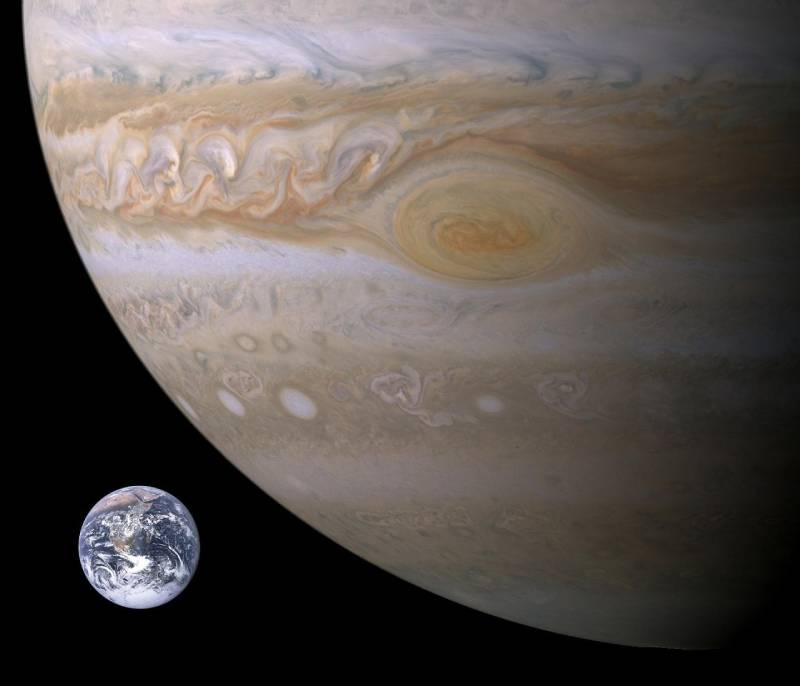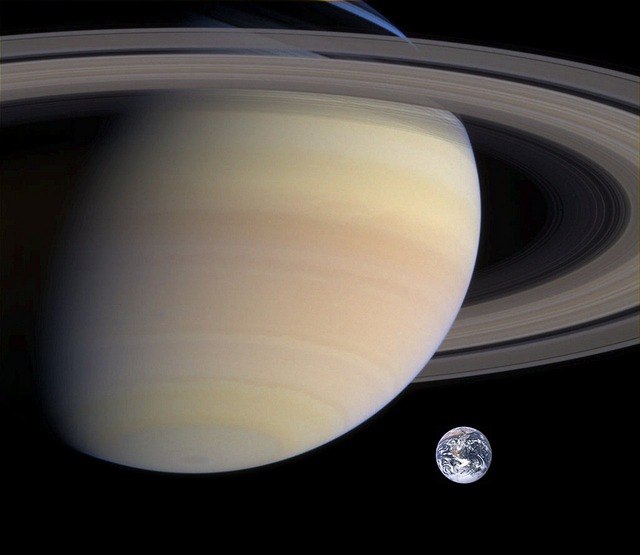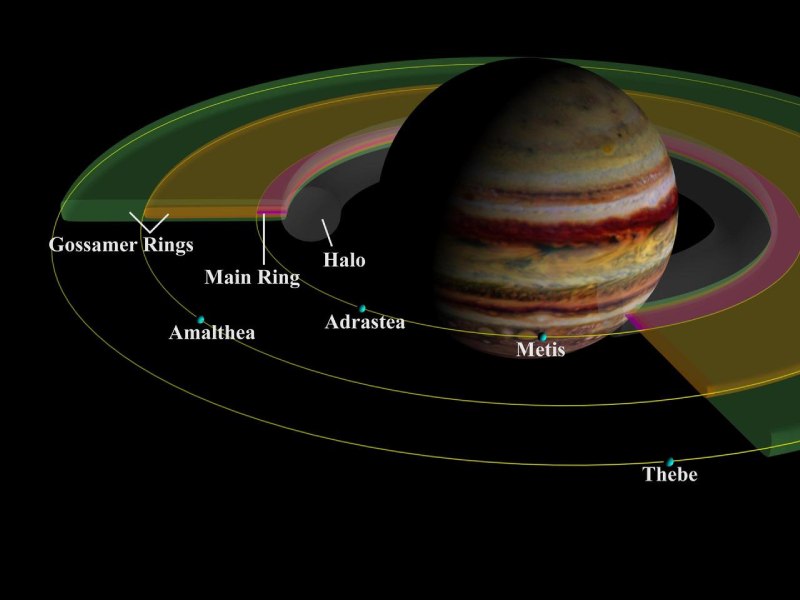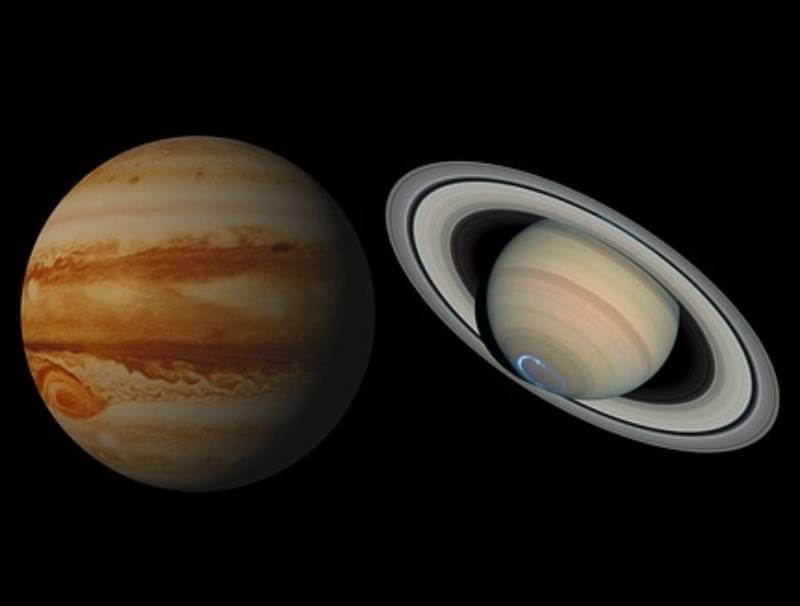The two largest planets in the solar system are Jupiter and Saturn. While Saturn’s mesmerizing ring system may give the illusion of greater size, it is not the largest planet. Jupiter is the largest planet in our solar system, boasting immense size, swirling storms, and a captivating presence.
Jupiter is the largest planet in our galaxy and it surpasses Saturn by both Volume and Mass. But, let’s not downplay the overall size of Saturn. Saturn is still the second-largest planet in the galaxy and is substantially bigger than the third-largest planet in the solar system, Uranus.
Saturn is 700 times larger than Earth while Uranus is only 4 times larger than Earth. So, we cannot take away the sheer magnitude of Saturn even if it’s not the largest planet.
Comparing the Size of the Two Gas Giants
The size of Jupiter becomes evident when considering that we can place almost 600 more Earths inside its boundaries compared to Saturn! That is a lot of extra Earths. Not only that, but Jupiter’s diameter surpasses Saturn’s by nearly 16,000 miles.
In addition, even if we were to combine the masses of all the planets, including Saturn, and multiply it by 2.5, it still falls short of matching Jupiter’s colossal mass. Jupiter’s size is so immense that it is difficult to comprehend its magnitude, leaving us in awe of the true scale of this gas giant.
Exploring the Magnitude of Jupiter
The size of Jupiter is hard for our minds to even comprehend. It towers over all of the other planets. To help visualize the sheer size of this massive planet, Jupiter’s diameter is more than 11 times that of Earth. If you were to add up the mass of all of the other planets it still wouldn’t compare to that of Jupiter.

Jupiter is quite honestly overwhelming to think about. The sheer magnitude of Jupiter’s volume is difficult to fathom, as it can encompass 1,300 Earths within its expansive boundaries. This planet is truly remarkable.
| Diameter | 88,695 miles |
| Mass | 1.9 x 1027 kg |
| Volume | 143,128 |
Jupiter holds a dominant presence. Its immense size is a result of its composition primarily being hydrogen and helium gases.
This gas giant’s mass is approximately 318 times that of Earth. Jupiter’s sheer mass generates an incredibly strong gravitational pull, influencing the dynamics of its surrounding space and interacting with its 79 moons (the four largest Io, Europa, Ganymede, and Callisto).
The Outstanding Size of Saturn
Saturn is a complete marvel in our solar system with its magnificent rings. Saturn is the second largest planet in the solar system falling short of Jupiter. The mass of Saturn is almost 95 times greater than that of Earth and its volume could accommodate 760 Earths. So, although not as large as Jupiter, it is still incredibly massive!

| Diameter | 72,400 miles |
| Mass | 5.683 × 10^26 kg |
| Volume | 82,713 |
Saturn’s substantial size becomes even more apparent when considering its mass, which is approximately 95 times that of Earth. These dimensions contribute to Saturn’s significant gravitational influence and its ability to maintain its iconic ring system.
Is Saturn with Its Rings Bigger Than Jupiter?
Saturn is known for its rings and is often referred to as the “ringed planet” due to its breathtaking and iconic ring system. If we were to include the majestic rings, would Saturn then be larger than Jupiter?
Saturn may appear larger than Jupiter in terms of visibility. Saturn’s rings do add a certain level of impressive dimension which gives it a broader and more expansive profile compared to Jupiter. The rings, although visually striking, do not significantly impact Saturn’s core size.
Jupiter Has Rings Too
Sometimes people forget that Jupiter, much like Saturn, also has rings! It is often an afterthought because Jupiter’s rings are not as pronounced or noticeable. They are not iconic in any way. We can’t include Saturn’s rings in the size equation or we would have to include Jupiter’s as well!
Jupiter’s rings are not as apparent, but why? Saturn’s and Jupiter’s rings have been studied for quite some time and scientists are still trying to answer this burning question.

Saturn’s rings are composed of icy particles while Jupiter’s rings are made out of fine dust and rocky material which makes them have lower reflectivity. Not only that, but the size of Saturn’s rings exceeds that of Jupiter’s. The larger surface area of Saturn’s rings allows for more sunlight to be scattered about – which results in a brighter appearance.
Of course, it is important to note, that scientists are continually making developments in their understanding of the rings and the composition. Right now, we know that not only do Saturn and Jupiter have different rings, Saturn’s rings are individually different as well (and there are hundreds).
Learning About Planet Rings
We cannot include Saturn’s rings into consideration when determining the size of the massive planet. Mostly because it isn’t the only planet that has rings. We only measure the size of the planet itself. Uranus, Neptune, and Jupiter all have ring systems as well! The overall size of the planet does not include the ring systems as part of their measurements or dimensions.
Uranus’s rings were discovered in 1977 and have been determined to be made up of dark particles, including dust and ice, and they are relatively thin and faint.
Neptune’s rings were discovered during the Voyager 2 spacecraft’s flyby in 1989. Neptune’s ring system consists of five main rings: Galle, Le Verrier, Lassell, Arago, and Adams. These rings are composed of a combination of dust, small rocks, and ice particles. They are very faint and hard to see.
Conclusion: Jupiter Reigns Supreme
When it comes down to comparing the sizes of Saturn and Jupiter, it is quite clear that Jupiter is the largest of the two huge gas giants. Jupiter’s substantial diameter, mass, and volume towers over those of Saturn. Jupiter’s impressive statistics solidify its position as the largest planet in our solar system.
We don’t know everything about Saturn and Jupiter but scientists are continuously hard at work trying to identify new and exciting characteristics of the massive planets. We hope that over the years our understanding will evolve and we will be able to learn more about our solar system and expand our knowledge through scientific discovery.

